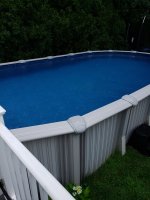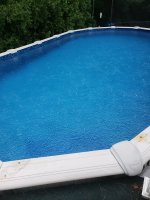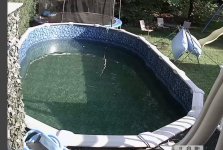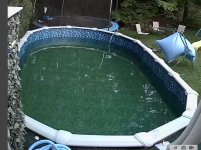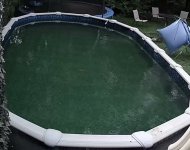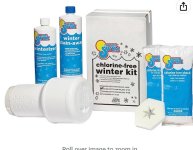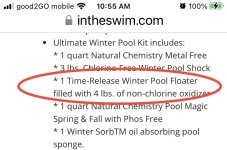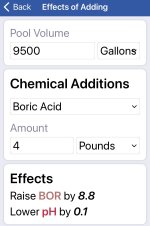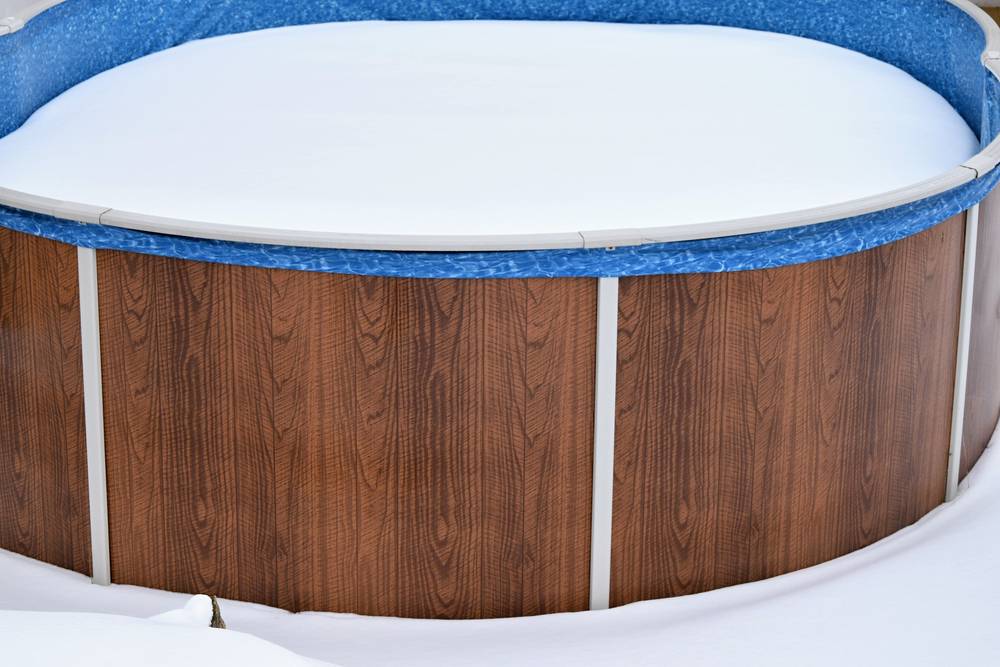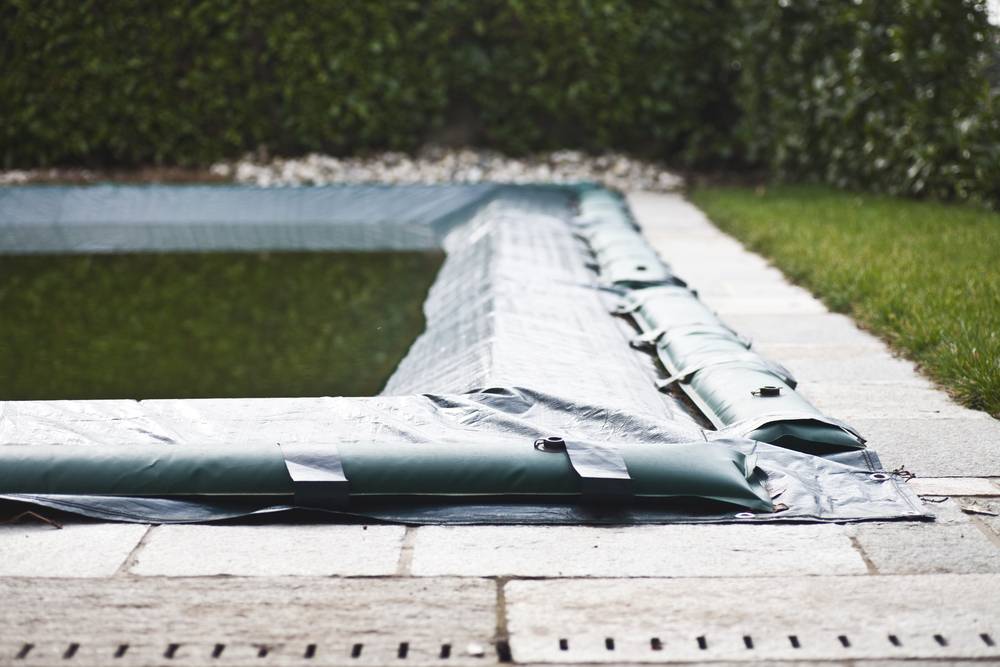This is long, so bear with me...I figured this was the place to post this, as there are a lot of pool nerds here who might dig the details...
Pool: above ground 12x24 oval, 52" depth, New England. History: we did not open the pool until 2 days ago. The water under the pool cover was blue and clear with almost no debris after sitting winterized for 10 months. However, our skimmer container was cracked, so we had to replace that, which meant draining the pool completely (so the holes would line up properly with the existing holes in our pool liner, which was stretching downward somewhat because of the weight of the water). Anyway, that doesn't really matter, all that matters is that we had to drain the pool to make the repair. We did not get inside the pool to scrub or wash the liner when it was empty, mainly because it didn't look dirty. Then we filled the pool right after completing the repair.
Here is where is gets strange. As we filled the pool with hose water, we noticed that the water in the pool was green, not super dark green but sort of a greenish yellow, but mostly clear. It wasn't cloudy and there were no clumps of algae. After the pool was filled to the top, there was a definite green color. In many years past, whenever we fill the pool from our hose, it is always looks crystal clear and blue, even if it has zero chlorine in it at first.
So I used a Taylor drop kit to test the green water. My test kit only shows up to 5 ppm, but the chlorine was off the chart, super dark. I tried another Taylor test kit I had fun last year that had just expired (not sure that matters) and this one measured up to 10 ppm, could have been higher who knows.
The CYA in the pool was zero. Total alkalinity was 30. pH was low, can't recall the value because i don't pay much attention to pH until total alkalinity is ok To make sure our municipal water supply did not have high chlorine levels, I tested the water coming straight from the hose, and it had zero chlorine.
As a side note, after we filled the pool with hose water, we fished out the winterizing container (the big plastic white sealed container that we poked holes in last fall to release the winterized chemicals, which stays in the pool all winter). This container may have been in the refilled pool water overnight, at least for the entire time it took to fill the pool with the hose (about 10-14 hours).
So. Why the green water?
Was it algae growth because we opened our pool too late? Had there been invisible algae on the pool walls and we just didn't notice, and once water got in there the algae just perked up and bloomed fast?
Or...
Was there so much chlorine from the winterizing container that it superchlorinated the fresh hose water enough to turn it green?
I still don't know.
So here is what I did. Yesterday around 6pm I adjusted the total alkalinity. This morning I retested TA and it was good, and the pool was slightly less green. Then I adjusted the pH to proper levels. The pool was definitely getting even less green. I tested the free chlorine again and surprise! It was zero. So I added chlorine stabilizer to get it up to 50 (I was aiming for 40 but whatever) and planned to add liquid shock after sunset. The pool seemed pretty clear and blue by early afternoon. Almost good enough to swim in.
Back when the water was green, I read how to SLAM a pool, thinking I'd have to do that to get rid of algae, but I don't have a FAS-DPD test, nor can I get one in time. So I bought a case of sodium hypochlorote (liquid 12%).
At 9pm tonight I poured 1 gallon in by the return. I read that slamming requires 10 oz of liquid shock for every 1ppm increase in free chlorine. The CYA/free chlorine chart said I needed to get my FC up to 20 ppm for slamming. That would be 200 oz, which is more than the 128 oz in my gallon jug. I have more i could add, but here's my dilemma.
I'm thinking that maybe I didn't have algae after all. The water is clear blue now and FC is high because of the gallon of shock. My CYA is higher than I wanted, so now I'm worried that it's going to take a long time for the free chlorine to come down to swimmable levels. I don't want to go out there tonight and add even more liquid shock if I don't need to, epecially since I cannot do a true SLAM because I cannot measure free chlorine with the accuracy needed, and I won't be able to tell if there has been more than 1ppm loss of free chlorine overnight (because of my run of the mill Taylor chlorine drop test).
That's why I'm reaching out here. What I do will depend on what I think caused the green water. What do you think? If the water is clear and blue and balanced and stabilized, is it safe to swim in once the chlorine levels come down to 4-5ppm?
UPDATE: This morning, I ran tests:
CYA: barely visible, maybe 20 at most? Yesterday it registered 50. Granted, my CYA reagent expired in May 2023, but I'm not sure if expired reagent would cause an abnormally high or abnormally low reading. I'm adding more, as technically I only added about half of what I needed to yesterday, and was surprised at the 50 result earlier.
Total Alkalinity - perfect (110)
pH - super high, probably over 8.2. I used pH decreaser to get it down to normal range. Likely caused by the torrential downpours we're having here in the Northeast.
Free Chlorine: Now here's the weird part: It was OFF THE CHARTS again, but I decided to look at the expiration date on my free chlorine reagent. It showed 5/2023. Presumably that is still sorta okay. I tested with two other reagent bottles, one from 4/22 and another from 5/23, and both of those registered ZERO free chlorine. I used a different comparator for those last two, but when I tried using the first 5/2023 reagent in the 2nd comparator, the FC came back off the charts still. I guess I'll go with the "off the charts" reading and assume the reagents that returned a zero result are expired.
Pool looks crystal clear and blue today.
Any advice/input/tell me TLDR?? lol
Pool: above ground 12x24 oval, 52" depth, New England. History: we did not open the pool until 2 days ago. The water under the pool cover was blue and clear with almost no debris after sitting winterized for 10 months. However, our skimmer container was cracked, so we had to replace that, which meant draining the pool completely (so the holes would line up properly with the existing holes in our pool liner, which was stretching downward somewhat because of the weight of the water). Anyway, that doesn't really matter, all that matters is that we had to drain the pool to make the repair. We did not get inside the pool to scrub or wash the liner when it was empty, mainly because it didn't look dirty. Then we filled the pool right after completing the repair.
Here is where is gets strange. As we filled the pool with hose water, we noticed that the water in the pool was green, not super dark green but sort of a greenish yellow, but mostly clear. It wasn't cloudy and there were no clumps of algae. After the pool was filled to the top, there was a definite green color. In many years past, whenever we fill the pool from our hose, it is always looks crystal clear and blue, even if it has zero chlorine in it at first.
So I used a Taylor drop kit to test the green water. My test kit only shows up to 5 ppm, but the chlorine was off the chart, super dark. I tried another Taylor test kit I had fun last year that had just expired (not sure that matters) and this one measured up to 10 ppm, could have been higher who knows.
The CYA in the pool was zero. Total alkalinity was 30. pH was low, can't recall the value because i don't pay much attention to pH until total alkalinity is ok To make sure our municipal water supply did not have high chlorine levels, I tested the water coming straight from the hose, and it had zero chlorine.
As a side note, after we filled the pool with hose water, we fished out the winterizing container (the big plastic white sealed container that we poked holes in last fall to release the winterized chemicals, which stays in the pool all winter). This container may have been in the refilled pool water overnight, at least for the entire time it took to fill the pool with the hose (about 10-14 hours).
So. Why the green water?
Was it algae growth because we opened our pool too late? Had there been invisible algae on the pool walls and we just didn't notice, and once water got in there the algae just perked up and bloomed fast?
Or...
Was there so much chlorine from the winterizing container that it superchlorinated the fresh hose water enough to turn it green?
I still don't know.
So here is what I did. Yesterday around 6pm I adjusted the total alkalinity. This morning I retested TA and it was good, and the pool was slightly less green. Then I adjusted the pH to proper levels. The pool was definitely getting even less green. I tested the free chlorine again and surprise! It was zero. So I added chlorine stabilizer to get it up to 50 (I was aiming for 40 but whatever) and planned to add liquid shock after sunset. The pool seemed pretty clear and blue by early afternoon. Almost good enough to swim in.
Back when the water was green, I read how to SLAM a pool, thinking I'd have to do that to get rid of algae, but I don't have a FAS-DPD test, nor can I get one in time. So I bought a case of sodium hypochlorote (liquid 12%).
At 9pm tonight I poured 1 gallon in by the return. I read that slamming requires 10 oz of liquid shock for every 1ppm increase in free chlorine. The CYA/free chlorine chart said I needed to get my FC up to 20 ppm for slamming. That would be 200 oz, which is more than the 128 oz in my gallon jug. I have more i could add, but here's my dilemma.
I'm thinking that maybe I didn't have algae after all. The water is clear blue now and FC is high because of the gallon of shock. My CYA is higher than I wanted, so now I'm worried that it's going to take a long time for the free chlorine to come down to swimmable levels. I don't want to go out there tonight and add even more liquid shock if I don't need to, epecially since I cannot do a true SLAM because I cannot measure free chlorine with the accuracy needed, and I won't be able to tell if there has been more than 1ppm loss of free chlorine overnight (because of my run of the mill Taylor chlorine drop test).
That's why I'm reaching out here. What I do will depend on what I think caused the green water. What do you think? If the water is clear and blue and balanced and stabilized, is it safe to swim in once the chlorine levels come down to 4-5ppm?
UPDATE: This morning, I ran tests:
CYA: barely visible, maybe 20 at most? Yesterday it registered 50. Granted, my CYA reagent expired in May 2023, but I'm not sure if expired reagent would cause an abnormally high or abnormally low reading. I'm adding more, as technically I only added about half of what I needed to yesterday, and was surprised at the 50 result earlier.
Total Alkalinity - perfect (110)
pH - super high, probably over 8.2. I used pH decreaser to get it down to normal range. Likely caused by the torrential downpours we're having here in the Northeast.
Free Chlorine: Now here's the weird part: It was OFF THE CHARTS again, but I decided to look at the expiration date on my free chlorine reagent. It showed 5/2023. Presumably that is still sorta okay. I tested with two other reagent bottles, one from 4/22 and another from 5/23, and both of those registered ZERO free chlorine. I used a different comparator for those last two, but when I tried using the first 5/2023 reagent in the 2nd comparator, the FC came back off the charts still. I guess I'll go with the "off the charts" reading and assume the reagents that returned a zero result are expired.
Pool looks crystal clear and blue today.
Any advice/input/tell me TLDR?? lol


